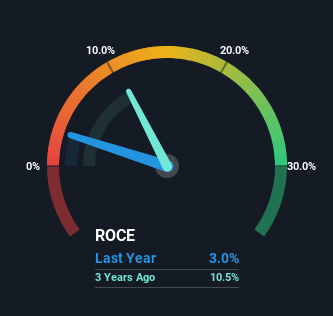- China
- /
- Electrical
- /
- SHSE:605288
Here's What's Concerning About ChangZhou KAIDI Electrical's (SHSE:605288) Returns On Capital
If we want to find a potential multi-bagger, often there are underlying trends that can provide clues. In a perfect world, we'd like to see a company investing more capital into its business and ideally the returns earned from that capital are also increasing. Ultimately, this demonstrates that it's a business that is reinvesting profits at increasing rates of return. However, after investigating ChangZhou KAIDI Electrical (SHSE:605288), we don't think it's current trends fit the mold of a multi-bagger.
What Is Return On Capital Employed (ROCE)?
For those that aren't sure what ROCE is, it measures the amount of pre-tax profits a company can generate from the capital employed in its business. Analysts use this formula to calculate it for ChangZhou KAIDI Electrical:
Return on Capital Employed = Earnings Before Interest and Tax (EBIT) ÷ (Total Assets - Current Liabilities)
0.03 = CN¥65m ÷ (CN¥2.7b - CN¥459m) (Based on the trailing twelve months to September 2023).
So, ChangZhou KAIDI Electrical has an ROCE of 3.0%. Ultimately, that's a low return and it under-performs the Electrical industry average of 6.5%.
Check out our latest analysis for ChangZhou KAIDI Electrical

While the past is not representative of the future, it can be helpful to know how a company has performed historically, which is why we have this chart above. If you're interested in investigating ChangZhou KAIDI Electrical's past further, check out this free graph covering ChangZhou KAIDI Electrical's past earnings, revenue and cash flow.
So How Is ChangZhou KAIDI Electrical's ROCE Trending?
When we looked at the ROCE trend at ChangZhou KAIDI Electrical, we didn't gain much confidence. Around five years ago the returns on capital were 50%, but since then they've fallen to 3.0%. Given the business is employing more capital while revenue has slipped, this is a bit concerning. This could mean that the business is losing its competitive advantage or market share, because while more money is being put into ventures, it's actually producing a lower return - "less bang for their buck" per se.
On a related note, ChangZhou KAIDI Electrical has decreased its current liabilities to 17% of total assets. So we could link some of this to the decrease in ROCE. What's more, this can reduce some aspects of risk to the business because now the company's suppliers or short-term creditors are funding less of its operations. Since the business is basically funding more of its operations with it's own money, you could argue this has made the business less efficient at generating ROCE.
Our Take On ChangZhou KAIDI Electrical's ROCE
In summary, we're somewhat concerned by ChangZhou KAIDI Electrical's diminishing returns on increasing amounts of capital. Long term shareholders who've owned the stock over the last three years have experienced a 61% depreciation in their investment, so it appears the market might not like these trends either. Unless there is a shift to a more positive trajectory in these metrics, we would look elsewhere.
If you'd like to know more about ChangZhou KAIDI Electrical, we've spotted 2 warning signs, and 1 of them is a bit concerning.
While ChangZhou KAIDI Electrical isn't earning the highest return, check out this free list of companies that are earning high returns on equity with solid balance sheets.
New: AI Stock Screener & Alerts
Our new AI Stock Screener scans the market every day to uncover opportunities.
• Dividend Powerhouses (3%+ Yield)
• Undervalued Small Caps with Insider Buying
• High growth Tech and AI Companies
Or build your own from over 50 metrics.
Have feedback on this article? Concerned about the content? Get in touch with us directly. Alternatively, email editorial-team (at) simplywallst.com.
This article by Simply Wall St is general in nature. We provide commentary based on historical data and analyst forecasts only using an unbiased methodology and our articles are not intended to be financial advice. It does not constitute a recommendation to buy or sell any stock, and does not take account of your objectives, or your financial situation. We aim to bring you long-term focused analysis driven by fundamental data. Note that our analysis may not factor in the latest price-sensitive company announcements or qualitative material. Simply Wall St has no position in any stocks mentioned.
About SHSE:605288
ChangZhou KAIDI Electrical
Changzhou Kaidi Electrical Co.,Ltd. researches, develops, manufactures, and sells linear drive systems in China and internationally.
Excellent balance sheet with low risk.
Market Insights
Community Narratives





